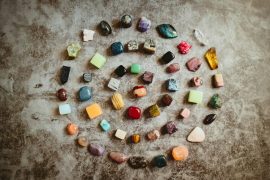Cubic zirconia (CZ) has emerged as a popular alternative to diamonds, prized for its likeness to the coveted gemstones. While it lacks the hardness characteristic of natural diamonds, CZ possesses its own unique set of properties that have contributed to its adoption in jewelry. A closer examination into the hardness of cubic zirconia reveals how it measures up in durability when compared to diamonds as well as various common materials utilized in jewelry.
Understanding the basics of cubic zirconia’s composition and how it fares on the Mohs scale of mineral hardness can offer insights into its scratch resistance and longevity. The question of whether CZ can rival the strength of natural diamonds or even everyday materials such as steel and glass is worth exploring to fully appreciate its place in the world of gemstones.
Key Takeaways
- Cubic zirconia is a common diamond alternative that is substantially hard, though not as hard as diamonds.
- Its durability on the Mohs scale reflects a balance of resilience and susceptibility to wear over time.
- The stone’s hardness is not equivalent to that of natural diamonds, steel, or glass, but it remains a favorable choice for jewelry.
Insights into Cubic Zirconia
Cubic zirconia, often abbreviated as CZ, is recognized for its exceptional similarity to diamonds in terms of visual appearance. Manufactured through a synthetic process, these stones serve as an affordable yet robust and sparkling counterpart to diamonds.
The creation of cubic zirconia dates back to the 1970s by Russian researchers, making it a relatively recent addition to the gemstone market. It mirrors the brilliance of diamond so closely that to the untrained eye, distinguishing the two can be challenging. Despite the visual similarities, cubic zirconia is noticeably more hefty, having a weight approximately 1.7 times that of a diamond, though it falls short of diamonds in hardness.
Key Characteristics of Cubic Zirconia:
- Origin: Lab-created from zirconium oxide.
- Formation: Subjected to extreme temperatures and pressures to achieve its characteristic brilliance.
- Durability: Highly durable, though less hard than diamonds.
- Weight: Generally heavier than diamonds.
The methods used to assess cubic zirconia’s quality draw from the diamond industry’s standards, utilizing the four Cs—cut, clarity, color, and carat weight. Additionally, a separate grading scale from I to VI categorizes cubic zirconia based on these attributes, influencing both quality and price.
A diverse assortment of cubic zirconia is obtainable due to advancements in manufacturing technologies. This includes not only transparent variants but also a palette of colors spanning from white to the more lavish pink and champagne hues.
Cubic Zirconia Color Spectrum:
- Colorless
- Black
- Lilac
- Pink
- Red
- Orange
- Yellow
- Brown
- Green
- Blue
It’s worth noting that while cubic zirconia is more affordable than diamonds due to its laboratory inception, it doesn’t invariably imply that it’s the cheapest option in the realm of gemstones. The highest-tier cubic zirconia, particularly those classified as grade VI, command higher prices, debunking the misconception that all lab-created stones are of low value. Regardless, even the most exquisite cubic zirconia gems are more accessible price-wise compared to their natural diamond counterparts.
Hardness of Cubic Zirconia and the Mohs Scale
Cubic Zirconia (CZ), a popular synthetic gemstone, exhibits a notable degree of hardness. It is positioned between 8.0 and 8.5 on the Mohs scale, a system used to classify the scratch resistance of various minerals. The scale itself extends from 1 to 10, with 1 being the softest, exemplified by talc, and 10 the hardest, represented by diamond.
CZ’s placement on the scale denotes its commendable durability, which contributes to its forefront position in cost-effective jewelry options. The stone’s sufficient hardness allows for long-lasting, sharp cuts, vital for maintaining the gem’s brilliance and reflective qualities.
Moreover, the highest-quality Cubic Zirconia available, known as 5A or AAAAA-graded, is rated an 8.5 on this hardness scale. Despite being softer than minerals such as sapphires and rubies, it remains a sturdy choice within the realm of affordable luxury.
Durability and Longevity of Cubic Zirconia
Cubic zirconia possesses a good level of resistance to abrasion with a hardness rating that falls between 8 and 8.5. This makes it less likely to acquire scratches from everyday contact with materials that are of equivalent or lower hardness. However, interactions with substances that rank higher on the Mohs scale can result in scratches on the cubic zirconia’s surface. Objects such as diamonds, moissanite, some varieties of garnet, corundum (materials of sapphire and ruby), and industrial materials designed to cut or scratch (such as those containing diamond powder) can mar its appearance. The use of tungsten carbide and specialized scratch-resistant glass for timepieces also falls into the category of materials that can scratch cubic zirconia. Regular care and caution are required to maintain its pristine condition over time.
Comparative Hardness: Cubic Zirconia vs. Diamond
- Cubic Zirconia: 8-8.5 on the Mohs scale
- Diamond: 10 on the Mohs scale
Comparison of Hardness: Cubic Zirconia vs. Steel
- Cubic Zirconia: 8.0-8.5 on Mohs scale
- Hardened Steel: 7.5 on Mohs scale
- Stainless Steel: 6.5 on Mohs scale
- Plain Steel: 5.0 on Mohs scale
Cubic zirconia surpasses various forms of steel in hardness, thus can scratch steel surfaces.
Comparative Hardness: Cubic Zirconia vs. Glass
- Cubic Zirconia (CZ) has a hardness of 8 to 8.5 on the Mohs scale.
- Glass has a significantly lower hardness of 5.5 on the same scale.
CZ can easily scratch glass due to its superior hardness. Handling these two materials should be done with care to avoid damage.
Synthesis
Manufactured cubic zirconia not only approaches the toughness of natural diamonds, rated between 8.0 and 8.5 on the Mohs scale of mineral hardness, but it also possesses an internal clarity that contributes to its luster. Its affordability relative to genuine diamonds makes it a popular choice for those seeking luxurious-looking jewelry without the hefty price tag. Its robustness ensures that only substances ranking higher on the hardness scale can scratch it, although its sparkle may diminish over time.
Price Variations:
- Cubic zirconia pricing is governed by an A-grade scale.
- Cost differences reflect varying quality levels within the category of cubic zirconia stones.
- Options are available to suit diverse budgets and preferences.
Durability and Maintenance:
- Generally maintains its condition well.
- Susceptible to dullness, periodic maintenance may restore its shine.
Fashion and jewelry enthusiasts value the versatility in styles and pricing that cubic zirconia offers. Those with expertise in the field, like jewelry manufacturing and metalwork, affirm the material’s adaptability and contribution to the growth of both small and large jewelry businesses. The material provides a dynamic range of options for different market segments.




